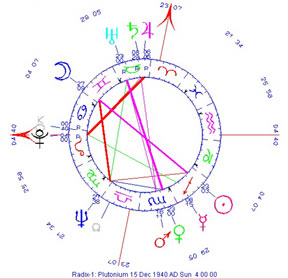
|
|
Plutonium and Pluto By Nick Kollerstrom Back to Metal-Planet Affinities index page The unnatural new element was made and bred under a cloak of absolute secrecy, as part of the wartime 'Manhatten Project.' For two years, it had no name. Ten years after the new planet Pluto had appeared in the heavens, this unnatural element appeared under the worst possible circumstances, as the world lurched into total war. As Pluto in mythology wore a helmet of invisibility, so plutonium is an element which none of us are ever likely to see. The world only heard about it when it exploded in New Mexico, turning the desert sand to glass. Pluto's turning-point The new planet Pluto appeared in 1930 conjunct its own node. Its orbit makes a steep angle to the ecliptic so this was quite a pronounced event; therefore its appearance was enormously powerful, as if some Hades-type principle had emerged into the light of day. In 1932 artificial transmutation began, and then in 1942 atomic energy was unleashed. In politics unheard-of horrors appeared, as if underworld principles had emerged: the victors of World War II somehow acquired the assumption that it was OK to target missiles on the cities of other nations. For the dreadful new weapons, Pluto's element was the trigger. Tension heightened until, in the 1980s, a majority of Britons were expecting the thermonuclear conflagration - remember? The necro-technocrats seemed to be in control. Hidden missiles deep in their silos, which we never saw, threatened to emerge into the light of day, and ‘cruise missiles’ were wheeled around Europe. The '80s were stressful because Pluto had entered within the orbit of Neptune. It came nearest in 1989. Its orbit is strongly elliptical, so this nearest approach (its ‘perihelion’) was quite marked. Once that distant sphere started to recede, the tension abruptly vanished: we could all forget about the terror of annihilation, and the shadow of the Bomb faded into yesterday's memory. The plutonium-crazed history of the nuclear arms race thus appears as framed by two events: Pluto crossing its node in 1930, then reaching its perihelion in 1989. A New god of darkness The Bard surveys plutonian history from midnight, Lit with Mercury Vapour streetlamps till in dawn's early light He contemplates a tranquil politic spaced out between Nations' thought-forms Proliferating bureaucratic & horrific arm'd, Satanic industries projected sudden with Five Hundred Billion Dollar Strength ... Ginsberg, Plutonian Ode (2) When Uranium was discovered in 1789, it was named after the new planet Uranus, found in 1781. No further elements beyond Uranium were discovered until after Pluto's appearance. Uranium was the ninety-second element in the Periodic Table of elements, and when the next two elements in this sequence turned up, elements 93 and 94, there was a kind of inevitability about their naming. They had to be named after the next two planets, and so were called neptunium and plutonium - both found at Berkeley using the new cyclotron. Glen Seaborg who named the new element had (it hardly needs saying) no inkling of the awful symbolic appropriateness of the name he was giving. He would have guessed it would be fissile, that's about all. Within the core of nuclear reactors, a transmutation-process goes through the sequence of the outer planet-names: The problem of who had what plutonium was an exciting government secret, labyrinthine in its deceptions. Pluto's domain gained its ‘plutocratic’ wealth from minerals, especially precious stones and metals, underground: advocates of a plutonium economy foresaw an era of cheap energy that would ensue from using it. The trouble was that a mere microgram (millionth of a gram) can kill, if lodged in the lungs. The dream (or nightmare) of plutonium-based reactors, called 'fast-breeder' reactors, seems to have died, around 'Pluto's turning-point' of 1989, due to world uranium costs dropping. Pluto Rising What new element before us unborn in nature? Is there a new thing under the Sun? At last inquisitive Whitman a modern epic, detonative, Scientific theme First penned unmindful by Doctor Seaborg with poisonous hand, Named for Death's planet through the sea beyond Uranus... Ginsberg, Plutonian Ode 
Chart for the Creation of Plutonium: Berkley cyctron, 8pm. Dec 14, 1940 There was a definite moment, when the endeavour to create a sample of plutonium began: in Berkeley, California, Glen Seaborg switched on the beam of the big cyclotron onto a sample of uranium. Seaborg's diaries give us the exact moment of this event. The previous summer neptunium had been made, and Seaborg's team decided to have a go for element 94. A beam of deuterium was focussed upon a uranium sample from 8.00 hours until midnight, on December 14th, 1940 (5). The chart for this moment has Pluto rising within half a degree. Sun, Moon and Earth are aligned (at Full-Moon) with the Galactic Centre at 27° of Sagittarius. That's our local black hole, which could be symbolically quite appropriate. Also in line is Seaborg's own Pluto, i.e. its position when he was born, at 27° of Gemini. |